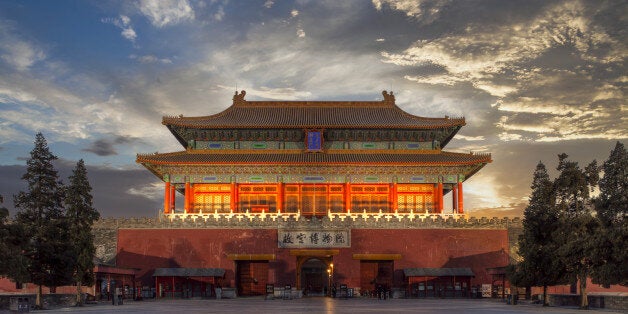
Professor Zhang Weiwei is the director of the Center for China Development Model Research, Fudan University and director of the Institute of China Studies, Shanghai Academy of Social Sciences. His recent publications include a bestseller in China "The China Wave, Rise of a Civilizational State."
SHANGHAI -- Is China's extraordinary rise a model of economic reform without political reform? Is China's Achilles' heel its political system? Is China's one-party governance doomed in the face of mounting challenges from a more diversified economy and demanding society?
These are questions in many Western minds whenever China is mentioned. But the assumptions behind these questions may be misplaced, as one's understanding of China could be vastly different if a Chinese perspective were adopted. China's political governance, adapting itself constantly to new challenges through many minor reforms, has proven crucial for China's economic success. The following five aspects of China's political governance merit special attention:
- First, one-party governance. In fact, there is nothing new about one-party governance in China: in most of the past two millennia since its first unification in 221 BC, China almost always practiced a kind of one-party rule, or rule by a unified Confucian ruling elite selected through public exams (the Keju), claiming to represent -- or genuinely representing -- most if not all under heaven. Furthermore, in most of the one-party-rule era, China was arguably a better governed country and a more prosperous economy than Europe of the same epoch. China only began to lag behind Europe when it closed its door to the outside world and missed the Industrial Revolution of the 18th century, but the country is now catching up fast.
The Communist Party of China has to a great extent followed this tradition and built an impressive system of selecting its leaders based on merit and performance. For instance, its top decision-makers (6 out of 7 Politburo's Standing Committee members) all worked at least twice as much as party secretaries or governors at the provincial level, which means they have on average administered a population of about 100 million before being promoted to their current positions in Beijing.
The CPC today, like its predecessors in China's long past, also claims to represent the whole nation, but with a mission to restore the country's premier world-class status. Key independent surveys, including those by the Pew or the Asian Barometer over the past decade, show a consistent pattern in which the Chinese central authorities command a high degree of respect and support (above 75 percent) within the country. Depicting China's polity as being on the verge of collapse, as appears so often in the Western media, is out of touch with China's reality.
In this context, the word "party" may be a misnomer for the CPC, as it bears no similarity with the type of political institutions like the Republican or Democratic parties of the U.S., which openly represent group interests of a society and compete with each other. The CPC has tried, in China's own political tradition, to represent the interests of the overwhelming majority of people, who apparently accept this, at least up to now, thanks largely to the fact that most people have found their living standards significantly improved over the past three decades.
In this sense, the CPC should better be viewed as a state party or, in a hypothetical American context, a merge of the Republican and Democratic parties in which competition of ideas and competence is the norm and consensus and can-do spirit is prized.
China is not an East Germany writ large awaiting a color revolution, as perceived by many in the West. Rather, it is a civilizational state, an amalgam of the world's longest continuous civilization with a huge modern state, which is also a product of hundreds of states amalgamated into one over its long history. It is analogous, perhaps, to the Roman Empire, but continuous to this day, with all its diverse regional and cultural differences joined to a modern economy and centralized government, with its people speaking the same one language like Latin.
This kind of state may indeed become ungovernable and break up if it ventures into the Western adversarial political model just as the Soviet Union did -- a lesson that Chinese leaders seem to have taken to heart. China's meritocratic system, in line with its own tradition and various adaptations such as widely practiced "selection plus election" governance system, seems working reasonably well for China. Imperfect as it is, this system can compete with other political models in the world.
- Second, neo-democratic centralism. China's success is inseparable from its much reformed decision-making process, which can be described as neo-democratic centralism or a modern form of democratic centralism. The old Soviet-style decision-making process was indeed more about centralism than democracy, but China has improved on it and institutionalized a procedural accountability for its democratic centralism. Under such a system, a typical major decision like the nation's five-year plan for development takes well over a year of extensive and interactive consultations at various levels of the Chinese state and the society, with several cycles of "from the people to the people, and to the people from the people".
This decision-making process receives inputs from thousands of think tanks, government agencies, universities, prominent scholars and professionals, including not infrequently heated debates in the social media and on the micro-blogging Weibo.
The recently adopted Third Plenum's decision on deepening reforms is a good example in this regard. Its drafting group, chaired by President Xi Jinping himself, solicited opinions from well over 100 institutions across the country and received 2500 suggestions over a period of half a year. About 50 percent of these suggestions were accepted. And during the process, all the seven top leaders went to different regions of China to make investigations in preparation for the deliberations on the decision.
As a result, the final decision reflects the broad consensus of Chinese society on many issues such as public health reform, adjustment of the one child policy, deferred retirement age, banking sector reform, education reform and the end of the "reform through labor" system. Many decisions are made based on the results of pilot projects.
With a higher degree of legitimacy in the decision-making process, there is usually no need to "sell" the state's decisions, as the United States does, to the public. Once decisions are made in Beijing after such a process, they are usually ready for "study and execution" or to be further tested in various pilot projects.
- Third, demand creation. Cycles of institutionalized consultations and policy debates in major decision-making processes tend to generate, at regular intervals, a lot of public expectations, usually more positive than negative, for economic development. Such expectations in turn create new and often medium to long term demand. A typical five-year plan in China catches the attention of the vast part of the Chinese society, from private firms to state-owned enterprises to individual shareholders. The fact that China has been able to sustain an annual GDP growth rate of over 9 percent for over three decades is inseparable from these regular and predictable cycles of expectation and demand creation.
- Fourth, development administration. It's not far from wrong to claim that China has created its own model of development, an important feature of which can be called "development adminstration," in contrast to public administration. China's five-year national plans and CPC's annual economic conference are definitely part of China's development administration. The same is true with many local development strategies and plans. Chinese universities may eventually offer courses and even degrees in development administration just as degrees in public administration are common everywhere.But the Chinese case may be unique, as the Chinese state, under the "socialist market economy," commands not only such Keynesian instruments as fiscal and monetary policies, but also other "tools," which may not be available in other countries, such as public ownership of land and of strategic resources as well as a largely performing state sector. These "tools" give the Chinese state greater leveraging power.
- Fifth, minyi versus minxin. Behind all the above is the Chinese philosophy of governance, including, inter alia, the two distinctive concepts: minyi and minxin, the former referring to "public opinion", and the latter to "the hearts and minds of the people" (approximate English translation), which was first put forward by Mencius (372 - 289 BC). Minyi or public opinion can be fleeting and change overnight, while minxin or "hearts and minds of the people" tends to be stable and lasting, reflecting the whole and long-term interest of a nation. Over the past three decades, even under the occasionally populist pressure of minyi, the Chinese state has still generally practiced "rule by minxin". This allows China to plan for medium to long terms and even for the next generation, rather than for next 100 days or next election as in many Western countries.
China is still faced with many daunting challenges ranging from corruption to regional income gaps and environmental degradation. But China is indeed better than at anytime in its modern history. The country is now the world's largest laboratory for economic, social and political experimentation. There is a every reason to believe that China, which has a continuously adaptive political system, will reach its objective of becoming the world's largest economy in a decade's time -- with all the implications for China itself and for the rest of the world at large.
